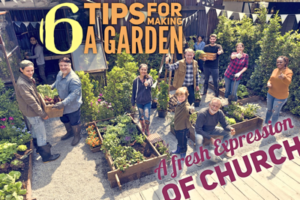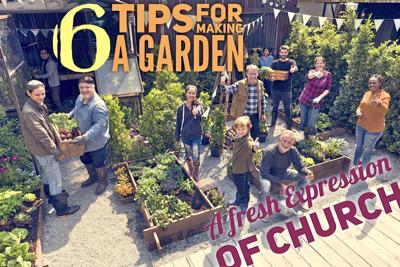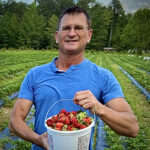By Kaya Prasad, Fresh Expressions US, student intern from Grinnell College

Churches, places of worship, in America often have three spaces: a foyer, Sunday school rooms and the sanctuary – that place where we sing worship. For those who want to get a little dirty, grow some food, become rooted in strong fellowship and do worship, a garden ministry is a fresh expression of church.
Beyond these conventional church spaces, many have created additional space to facilitate more interaction and activities like a fellowship hall, a library/bookstore, café, youth center and one of our favorites — a fitness facility.
However, outside the building walls, churches typically have a parking lot and yard. A few, often those operating a school or childcare service, have a playground. Additional intentional outdoor church spaces can include a sports field or a quite space like a labyrinth for prayer and meditation.
As community awareness and interest in better health and nutrition blossoms, churches are increasingly discovering how a garden is an extremely versatile, practical and welcoming space to build community physically and spiritually.
In comparison to church ministry initiatives that require indoor square footage from an existing building or new construction, a garden ministry is a place of worship that has an extremely low cost making it relatively easy to start and maintain. At the same time there is a potential for a high return when it comes to the church’s mission to community engagement.

Fresh Expressions is a movement that originally started in the UK and has spread to the US. Fresh Expressions is an international movement of missionary disciples cultivating new kinds of church alongside existing congregations to more effectively engage our growing post-Christian society. We asked Kaya Prasad to share some guiding principles for those who want to make a garden a fresh expression of church.
TIP #1: LISTEN

If you want to start a community garden that is a garden ministry, it’s essential to know the community. Ask your neighbors what they’d like to see grown in the garden. Find out what people need, and pray attentively for God to open your eyes and heart to the things He has prepared for you. Leaders like ‘Man In Overalls’ Nathan Ballentine can help you with this.
ripen – a gardening lifestyle magazine can help you create customized and easy to use surveys that you can use. The survey can be done in-person door-to-door or at your facility location. In-person facility gatherings are a great way to introduce those in your community to the vibe of your ministry/organization and can even be done over a garden meal. Surveys can also be done well through online communication tools (website, email, social media and even texting).
TIP #2: LOVE AND SERVE

Once you’ve spent some time listening to your neighbors and you’ve heard about their lives and their struggles, you can’t help but love them. The hope is that those you meet might want to join in the gardening project with you. Turn your empathy in to action that invites others into a mutually beneficial experience. Grow healthy, tasty vegetables for the surrounding community, and invite others into the process through a conversation [an act of worship] over weed-pulling. This is a natural way to to participate with excellence and live faithfully.
This is an aspect of your garden ministry that should incorporate a training session for those church leaders and members who will serve. To “love and serve” is, to most people, an obvious part of what should naturally be happening. But, drawing on resources like Loving Your Community – Proven Practices For Community-based Outreach Ministry by Dr. Stephen Viars or Loving God And Others by Kay Arthur or several other books can really prepare your ‘team’ to do the ministry of garden ministry well. We can help you to prayerfully consider, define and refine your mission so that your Love And Serve strategy is both thoughtfully unique for your community and fluid for ever changing needs and circumstances.
TIP #3: BUILD COMMUNITY

Like thousands of honeybees that act together as a single hive, a church consists of many individuals functioning in unity. More than a mere social network, a community is a collection of people whose sense of self includes all the others. As you share in the tasks of gardening with your neighbors, engage them in conversations that challenge everyone. Start to see life through each other’s eyes and live as one by bearing one another’s burdens and building each other up in love.
Should the community that God is building through your garden ministry be limited to just those who can garden at your church campus? Absolutely not. An important part of building community is going into the community, connecting with other leaders, businesses and organizations and creating other garden spaces throughout your city. This could include gym facilities, restaurants, other churches, public and private spaces, malls and more. The Faith & Fitness Magazine team can help you in this process.
TIP #4: MAKE DISCIPLES

When you and your fellow gardeners have become a community, each one invested in the lives of the others, they will want to hear about the truth that sustains and inspires you. The Bible is filled with images of sowing and reaping. See the garden as an opportunity to share the gospel (Christian teachings); take advantage of the time and the space to have focused conversations, and borrow images from the soil, the plants, and the work of your hands. Follow Jesus’ example to teach your neighbors the truth you’ve received from God, and walk alongside them as they learn—and teach you—to apply it.
Discipleship happens on many different levels. We can help you to tap into the strengths of your members and community so that everyone can disciple. The tasks and opportunities are many with a gardening ministry. It’s important to distribute the roles, build involvement and reinforce the bigger vision to disciple all in Christ.
This is so much more than singing worship – this is doing worship. THIS is church. THIS is worship!
TIP #5 FORM CHURCH

Gather regularly. Praise God for the garden and for the physical and spiritual nourishment that it provides through the vegetables and stories it sprouts. Read and discuss the Bible. Feast together. Pray together. Love together. Over time, the expression of church will take up practices that are rooted in this particular context. The conversations from the garden continue and grow deeper when you come to the family table to eat and celebrate as one community.
One of the most important concepts to understand and embrace is that a fresh expression of church IS CHURCH. Your garden ministry can and should serve as a fully functioning church. When you build your ministry this way then you transition to a freedom to really act as a dynamic church. Your agenda isn’t to eventually get garden ministry participants “into the church building” it is simply to do the work of the church.
TIP #6: DO IT AGAIN

No plant in the garden lives and dies for itself; most produce seeds, which are carried to new places where they, too, can be nourished and grow. When your garden church bears fruit, take the seeds and plant another garden; find another place to listen, love, serve, build community, make disciples, form church, and do it again.
CONTACT US for help in starting a garden ministry.
This article originally appeared in the Gardening Department of the August/September 2017 issue of Faith & Fitness Magazine.






